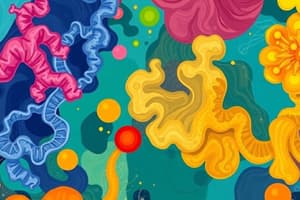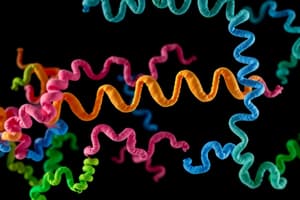Podcast
Questions and Answers
Which characteristic is true of fibrous proteins?
Which characteristic is true of fibrous proteins?
- They primarily perform regulatory functions.
- They are mainly involved in transport.
- They catalyze biological reactions.
- They provide mechanical properties and support. (correct)
What defines globular proteins?
What defines globular proteins?
- They have a compact, spherical shape and often perform various functions. (correct)
- They are particularly rigid and inflexible.
- They consist only of basic amino acids.
- They are primarily involved in structural support.
Which of the following statements differentiates keratin from collagen?
Which of the following statements differentiates keratin from collagen?
- Keratin has regulatory functions, whereas collagen catalyzes reactions.
- Both keratin and collagen are globular proteins.
- Keratin provides support while collagen is involved in transport.
- Keratin is a fibrous protein, mainly found in hair and nails, while collagen is found in connective tissues. (correct)
Which protein category includes molecules other than amino acids?
Which protein category includes molecules other than amino acids?
What function does myoglobin primarily serve?
What function does myoglobin primarily serve?
What is the primary characteristic of fibrous proteins?
What is the primary characteristic of fibrous proteins?
Which of the following proteins is classified as mesenchymal?
Which of the following proteins is classified as mesenchymal?
What role do disulfide bonds play in keratin?
What role do disulfide bonds play in keratin?
How does the cysteine content in hair keratin affect its properties?
How does the cysteine content in hair keratin affect its properties?
What percentage of total protein does collagen constitute in the human body?
What percentage of total protein does collagen constitute in the human body?
What primary function does myoglobin serve in the human body?
What primary function does myoglobin serve in the human body?
What structural feature allows hemoglobin to bind up to four molecules of oxygen?
What structural feature allows hemoglobin to bind up to four molecules of oxygen?
Which characteristic distinguishes globulins from albumins?
Which characteristic distinguishes globulins from albumins?
What role does the heme pocket in hemoglobin play?
What role does the heme pocket in hemoglobin play?
Which function is least associated with the albumin protein family?
Which function is least associated with the albumin protein family?
What is the composition of adult hemoglobin HbA?
What is the composition of adult hemoglobin HbA?
In which state does hemoglobin have a low affinity for oxygen?
In which state does hemoglobin have a low affinity for oxygen?
Which of the following hemoglobins is associated with fetal development?
Which of the following hemoglobins is associated with fetal development?
How does the glycosylation ratio of hemoglobin relate to glucose concentration?
How does the glycosylation ratio of hemoglobin relate to glucose concentration?
What happens when O2 is released from hemoglobin?
What happens when O2 is released from hemoglobin?
What type of cross-links are present in elastin?
What type of cross-links are present in elastin?
How does collagen differ structurally from elastin?
How does collagen differ structurally from elastin?
Which of the following is NOT a characteristic of silk fibroin?
Which of the following is NOT a characteristic of silk fibroin?
What is a common feature of globular proteins?
What is a common feature of globular proteins?
What is the presence of hydroxylysine in collagen indicative of?
What is the presence of hydroxylysine in collagen indicative of?
In the context of elastin, what does the term 'random coils' refer to?
In the context of elastin, what does the term 'random coils' refer to?
Which type of modification is present in elastin but absent in collagen?
Which type of modification is present in elastin but absent in collagen?
What governs the stability of silk fibroin?
What governs the stability of silk fibroin?
Which of the following is a feature of collagen?
Which of the following is a feature of collagen?
Which amino acid is in high concentration in silk fibroin?
Which amino acid is in high concentration in silk fibroin?
What causes the decrease in oxygen affinity in hemoglobin in response to increased carbon dioxide concentration?
What causes the decrease in oxygen affinity in hemoglobin in response to increased carbon dioxide concentration?
What role does 2,3-BPG play in the oxygen transport process?
What role does 2,3-BPG play in the oxygen transport process?
Why is 2,3-BPG important for transfused blood?
Why is 2,3-BPG important for transfused blood?
What is one consequence of a decrease in pH on the hemoglobin dissociation curve?
What is one consequence of a decrease in pH on the hemoglobin dissociation curve?
What happens to 2,3-BPG during the storage of blood for transfusion?
What happens to 2,3-BPG during the storage of blood for transfusion?
Which of the following explains the chloride shift in relation to carbon dioxide transport?
Which of the following explains the chloride shift in relation to carbon dioxide transport?
What is the primary consequence of carbon monoxide exposure on hemoglobin?
What is the primary consequence of carbon monoxide exposure on hemoglobin?
In the presence of 2,3-BPG, how does hemoglobin's affinity for oxygen change?
In the presence of 2,3-BPG, how does hemoglobin's affinity for oxygen change?
Flashcards
Protein Classification
Protein Classification
Proteins are categorized based on their shape or composition.
Fibrous proteins
Fibrous proteins
Structural proteins with elongated shapes, providing support and protection.
Globular proteins
Globular proteins
Proteins with complex shapes, crucial for regulation, catalysis, and transport.
Simple proteins
Simple proteins
Signup and view all the flashcards
Conjugated proteins
Conjugated proteins
Signup and view all the flashcards
Apoprotein
Apoprotein
Signup and view all the flashcards
Heteroproteins
Heteroproteins
Signup and view all the flashcards
Scleroproteins
Scleroproteins
Signup and view all the flashcards
Collagen: Structure
Collagen: Structure
Signup and view all the flashcards
Collagen: Function
Collagen: Function
Signup and view all the flashcards
Albumin
Albumin
Signup and view all the flashcards
Globulin
Globulin
Signup and view all the flashcards
Immunoglobulin
Immunoglobulin
Signup and view all the flashcards
Heme
Heme
Signup and view all the flashcards
Myoglobin: Function
Myoglobin: Function
Signup and view all the flashcards
Elastin Cross-links
Elastin Cross-links
Signup and view all the flashcards
Collagen vs. Elastin: Genetic Types
Collagen vs. Elastin: Genetic Types
Signup and view all the flashcards
Collagen vs. Elastin: Structure
Collagen vs. Elastin: Structure
Signup and view all the flashcards
Collagen vs. Elastin: Hydroxylysine
Collagen vs. Elastin: Hydroxylysine
Signup and view all the flashcards
Collagen vs. Elastin: Carbohydrate Modification
Collagen vs. Elastin: Carbohydrate Modification
Signup and view all the flashcards
Collagen vs. Elastin: Cross-links
Collagen vs. Elastin: Cross-links
Signup and view all the flashcards
Collagen vs. Elastin: Biosynthesis
Collagen vs. Elastin: Biosynthesis
Signup and view all the flashcards
Silk Fibroin: Structure
Silk Fibroin: Structure
Signup and view all the flashcards
Silk Fibroin: R Groups
Silk Fibroin: R Groups
Signup and view all the flashcards
Silk Fibroin: Stability
Silk Fibroin: Stability
Signup and view all the flashcards
Hb Gower 1
Hb Gower 1
Signup and view all the flashcards
HbF (Fetal Hemoglobin)
HbF (Fetal Hemoglobin)
Signup and view all the flashcards
HbA (Adult Hemoglobin)
HbA (Adult Hemoglobin)
Signup and view all the flashcards
HbA2 (Minor Adult Hemoglobin)
HbA2 (Minor Adult Hemoglobin)
Signup and view all the flashcards
DeoxyHb vs. OxyHb
DeoxyHb vs. OxyHb
Signup and view all the flashcards
Bohr Effect
Bohr Effect
Signup and view all the flashcards
Carbonic anhydrase
Carbonic anhydrase
Signup and view all the flashcards
Chloride shift
Chloride shift
Signup and view all the flashcards
How does the Bohr Effect affect oxygen delivery?
How does the Bohr Effect affect oxygen delivery?
Signup and view all the flashcards
2,3-BPG
2,3-BPG
Signup and view all the flashcards
Why is 2,3-BPG important in transfused blood?
Why is 2,3-BPG important in transfused blood?
Signup and view all the flashcards
HbO2 dissociation curve shift
HbO2 dissociation curve shift
Signup and view all the flashcards
Carbon monoxide poisoning
Carbon monoxide poisoning
Signup and view all the flashcards
Study Notes
Protein Classification and Function
- Proteins are classified based on shape (structural) and composition.
- Structural proteins have shapes determined by their amino acid sequence.
- Fibrous proteins provide structural support, shape, and mechanical properties. Examples include keratin, collagen, elastin, silk fibroin, and muscle proteins (tropomyosin, myosin).
- Globular proteins are typically round and soluble in water. Functions include regulation, catalytic activity, transport, and form hormones and receptors.
- Compositional classification divides proteins into simple and conjugated.
- Simple proteins are composed solely of amino acids (homoproteins).
- Conjugated proteins contain non-amino acid components (heteroproteins). These components include metals (metalloproteins), lipids (lipoproteins), carbohydrates (glycoproteins), etc.
- Some conjugated proteins have prosthetic groups; these are non-amino acid parts.
Learning Objectives
- Classify proteins based on shape and composition.
- Describe the structural properties of fibrous proteins.
- Explain the structural differences among keratin, collagen, and elastin.
- Define globular proteins and their structural properties.
- Explain the structure and function of myoglobin and its oxygen saturation.
- Explain the structure and function of hemoglobin and its oxygen saturation.
Fibrous Proteins
- Scleroproteins are insoluble in water, not digestible, and resistant to heat (thermostable).
- They provide mechanical strength, like in hair, nails, horns, and connective tissues. Keratin, collagen, and elastin are examples.
- Collagen forms the triple helix structure, giving strength and flexibility to connective tissues.
- Elastin is crucial in tissues that need elasticity, providing recovery after being stretched.
- Silk fibroin contains amino acids glycine and alanine, forming a β-sheet structure. It provides flexibility and strength.
- Muscle proteins like tropomyosin and myosin are fibrous proteins supporting movement.
Classification of Proteins
- Structural (shape): Fibrous (supports cell shape, protective roles, mechanical properties) vs. Globular (regulation, catalytic activity, transport, hormones, receptors).
- Composition: Simple (only amino acids) vs. Conjugated (non-amino acid components).
Keratin
- Keratin structure consists of α-helices, coiled to form fibers.
- Cysteine content affects keratin's properties (e.g., hardness).
- Disulfide bonds contribute to keratin's insolubility.
- Cysteine is lower in skin keratin compared to hair or nails.
Collagen
- Collagen is ~30% of total body protein and 6% of body weight.
- There are varying types with different functions.
- Physical properties (elasticity, hardness) depend on the collagen type.
- Collagen's structure includes a triple helix and hydroxyproline (Hyp).
- Collagen is a critical component of connective tissues.
Elastin
- Elastin provides durability and flexibility, found in skin, blood vessels, and lungs.
- Elastin is a hydrophobic protein, rich in glycine, alanine, and lysine, and has small amounts of hydroxyproline, but no hydroxylysine.
- Cross-linking is crucial for elastin's elasticity, via Lysyl oxidase.
Silk Fibroin
- Silk fibroin forms a β-sheet structure made from amino acids glycine and alanine.
- The β-sheet structure contributes to its strength and flexibility.
- Many weak bonds (hydrogen and van der Waals) contribute to silk's stability.
Globular Proteins
- High solubility in water.
- Mostly conjugated (bound with different molecules besides amino acids).
- Diverse functions (catalysis, transport, storage, gene regulation, immunity).
- Examples include albumins and globulins, myoglobin, and hemoglobin.
Albumins
- Common in blood, ~50% of the plasma proteins.
- Transport substances like hormones, fatty acids, and ions.
- They connect between substances and send signals.
Globulins
- Larger than albumins, less soluble in water.
- Three major classes: alpha, beta, and gamma globulins.
- Gamma globulins include antibodies, critical for the immune system.
Globin (Globulin subclass)
- Contains a heme group—a ferrous iron atom connected to a porphyrin ring.
- Has oxygen-binding properties.
- Examples: Myoglobin and Hemoglobin.
Myoglobin
- Single polypeptide, stores oxygen in muscles.
- Binds oxygen even at low concentrations.
- Single polypeptide chain.
Hemoglobin
- Four polypeptide chains (2 alpha, 2 beta), carries oxygen in the blood.
- Binds oxygen at high concentrations and releases it at low concentrations.
- Can bind CO2 and hydrogen.
- 4 heme groups can bind 4 oxygen molecules.
Hemoglobin Types
- Different types of hemoglobin exist including HbA, HbA2, HbF. These exist in different concentrations at different stages of life.
Glycosylated Hemoglobin (HbA1c)
- Glycosylation ratio is dependent on blood glucose concentration.
- Indicator of diabetes control
2,3-BPG binding to Hemoglobin
- 2,3-BPG is a side product of glycolysis.
- It binds to hemoglobin and decreases its affinity for oxygen, promoting oxygen release in tissues.
- Affects the Hb oxygen dissociation curve.
Carbon Monoxide
- A toxicant, binds to heme's iron, reducing blood's oxygen-carrying capacity.
- The binding is highly reversible, which allows for treatments to restore the oxygen-binding capacity of hemoglobin
Bohr Effect
- CO2 and H+ levels affect hemoglobin's oxygen-binding affinity.
- When CO2 increases, the affinity decreases (Bohr effect).
Studying That Suits You
Use AI to generate personalized quizzes and flashcards to suit your learning preferences.




